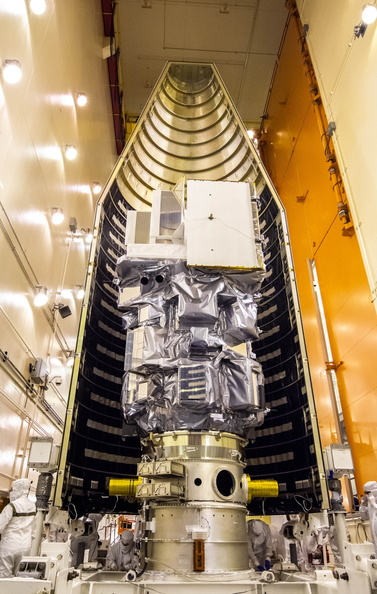
WIKIARCHIVES.SPACE
The Human Spaceflight Archive

Information
- Taken in
- Vandenberg
- Author
- NASA/Randy Beaudoin
- Description
- Inside the Integrated Processing Facility at Vandenberg Space Force Base in California, the Landsat 9 spacecraft is moved into position for encapsulation on Aug. 16, 2021. The two halves of the United Launch Alliance (ULA) payload fairing will surround and encase Landsat 9 to protect it during launch atop the ULA Atlas V rocket. Landsat 9 will launch on the Atlas V rocket from Space Launch Complex 3 at Vandenberg in September 2021. The launch is being managed by NASA’s Launch Services Program based at Kennedy Space Center, America’s multi-user spaceport. The Landsat 9 satellite will continue the nearly 50-year legacy of previous Landsat missions. It will monitor key natural and economic resources from orbit. Landsat 9 is managed by the agency’s Goddard Space Flight Center in Greenbelt, Maryland. The satellite will carry two instruments: the Operational Land Imager 2, which collects images of Earth’s landscapes in visible, near infrared and shortwave infrared light, and the Thermal Infrared Sensor 2, which measures the temperature of land surfaces. Like its predecessors, Landsat 9 is a joint mission between NASA and the U.S. Geological Survey
- Created on
- Monday 16 August 2021
- Source link
- https://www.flickr.com/photos/nasakennedy/albums/72157719454254597
- Visits
- 112
- Rating score
- no rate
- Rate this photo
- License
- CC BY-NC-ND
- Modified by WikiArchives
- No (original)
- Downloads
- 9
EXIF Metadata
NIKON CORPORATION NIKON D7100
- Make
- NIKON CORPORATION
- Model
- NIKON D7100
- DateTimeOriginal
- 2021:08:16 08:35:50
- ApertureFNumber
- f/9.0
Powered by Piwigo





























